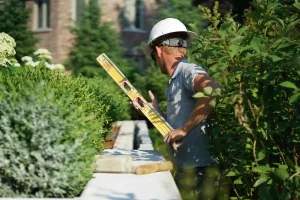Homeowners face many expenses in maintaining their property. Best practices for outdoor maintenance can help prevent costly repairs that arise when yard care is neglected. By being proactive about outdoor maintenance, you avoid financial pitfalls and ensure long-term savings. Regular maintenance practices, such as cleaning gutters, trimming trees, and checking irrigation systems, have a positive impact on your wallet. Overlooking these tasks can lead to expensive repairs and replacements, so identifying areas of your yard that need attention is key to saving money in the long run.
Key Takeaways
- Regular outdoor maintenance helps prevent costly repairs by identifying and addressing potential issues before they escalate.
- Proper pruning and trimming of trees and shrubs saves money by avoiding damage to rooflines, windows, and walkways.
- Inspecting and cleaning gutters and downspouts prevents water damage, erosion, and foundation problems, reducing maintenance costs.
- Adopting sustainable practices like rainwater harvesting and eco-friendly gardening products reduces environmental impact and lowers maintenance costs.
- Staying organized and keeping track of maintenance tasks and schedules helps homeowners prioritize tasks and avoid missed repairs.
Common Outdoor Maintenance Mistakes
Behind every well-manicured lawn and tidy outdoor space lies a homeowner who has mastered the art of avoiding common outdoor maintenance mistakes. These oversights can lead to costly repairs, reduced property value, and even safety hazards. One frequent mistake is neglecting to prune trees and shrubs, allowing them to overgrow and obstruct walkways, windows, and rooflines. Another error is improper lawn mowing, leaving grass clippings to accumulate and create an ideal environment for pests and diseases. Moreover, failing to inspect and clean gutters and downspouts can cause water damage, erosion, and foundation problems. Additionally, not addressing soil erosion and poor drainage issues can lead to landscape destruction and structural damage to the home. By recognizing and rectifying these mistakes, homeowners can adopt best practices for outdoor maintenance, ensuring a beautiful, functional, and safe outdoor space that enhances their property’s value and their quality of life.
Benefits of Regular Yard Upkeep
Regular yard upkeep is a vital component of outdoor maintenance, catapulting homeowners into a domain of numerous benefits that extend beyond mere aesthetics. By dedicating time and effort to regular yard upkeep, homeowners can reap rewards that impact their wallets and their well-being. For instance, a well-maintained yard can increase property value, making it more attractive to potential buyers if and when the time comes to sell. In addition, regular yard upkeep can also reduce the risk of costly repairs by identifying and addressing potential issues before they escalate. Additionally, a tidy yard can boost curb appeal, creating a sense of community and belonging among neighbors. By adopting best practices for outdoor maintenance, homeowners can enjoy these benefits and more, ultimately saving money and enhancing their quality of life. By staying on top of yard upkeep, homeowners can create a welcoming outdoor space that not only looks great but also provides a sense of pride and satisfaction.
Best Practices for Outdoor Maintenance
In conjunction with a well-planned maintenance schedule, adopting best practices for outdoor maintenance is crucial to maximizing the benefits of regular yard upkeep. These practices encompass a range of activities designed to preserve and enhance the aesthetic appeal, functionality, and longevity of outdoor spaces.

Effective right practices for outdoor maintenance involve regular inspections to identify potential issues before they escalate, such as monitoring for signs of pest infestations, disease, or nutrient deficiencies in plants. It also involves implementing preventative measures, like mulching and pruning, to maintain soil health and promote healthy plant growth. In addition, incorporating sustainable practices, like rainwater harvesting and using eco-friendly gardening products, can substantially reduce environmental impact and lower maintenance costs.
Preventing Costly Repairs and Replacements
Vigilance is the cornerstone of a cost-effective outdoor maintenance strategy, as it enables homeowners to detect and address potential issues before they mushroom into costly repairs and replacements. By adopting best practices for outdoor maintenance, homeowners can identify and rectify minor problems before they escalate into major expenses. Regular inspections of outdoor structures, such as decks, patios, and fences, can reveal signs of wear and tear, allowing homeowners to perform prompt repairs and prevent further damage. Additionally, monitoring outdoor systems, including irrigation and drainage, can help prevent water damage and erosion. Implementing a proactive maintenance approach can also extend the lifespan of outdoor features, reducing the need for premature replacements. By staying on top of maintenance tasks, homeowners can avoid the financial burden of costly repairs and replacements, freeing up resources for more enjoyable pursuits.
Seasonal Maintenance Tasks to Prioritize
As the seasons change, outdoor features and systems require tailored attention to guarantee they remain functional and safe. To certify your outdoor spaces continue to thrive, prioritize the following seasonal maintenance tasks.
In the spring, focus on inspecting and cleaning gutters, downspouts, and drains to prevent water accumulation and damage. Trim trees and shrubs to maintain a safe distance from your home and prevent overgrowth. Summer is the ideal time to inspect and repair fencing, as well as power wash decks and patios to remove dirt and grime. In the fall, prepare your outdoor spaces for winter by storing outdoor furniture, cleaning and storing gardening equipment, and inspecting roof flashing and chimneys. During the winter months, verify snow removal equipment is in good working order, and inspect outdoor faucets for freezing and damage.
Frequently Asked Questions
How Often Should I Inspect and Clean My Outdoor Gutters and Downspouts?
Regular inspections and cleaning of outdoor gutters and downspouts are vital to prevent water damage and foundation issues. Inspect and clean them at least twice a year, or more frequently after heavy rainfall or storms, to guarantee proper water flow and prevent costly repairs.
Can I Use a Pressure Washer to Clean My Outdoor Surfaces and Furniture?
When considering outdoor surface and furniture cleaning, exercise caution with pressure washers, as high-pressure streams can damage delicate materials; instead, opt for a wide fan tip and low to moderate pressure to effectively remove dirt and grime without causing harm.
Are There Any Specific Outdoor Maintenance Tasks for Homes Near Bodies of Water?
For homes near bodies of water, prioritize tasks that mitigate water-borne damage, such as regular gutter cleaning, dock inspections, and salt-resistant coating applications to protect exterior surfaces from corrosion and erosion.
How Do I Determine the Best Type of Outdoor Lighting for My Home’s Exterior?
To determine the best type of outdoor lighting for your home’s exterior, consider factors such as ambiance, safety, and energy efficiency, and assess your home’s architecture, surrounding landscape, and local climate to select fixtures that enhance curb appeal and functionality.
Is It Necessary to Hire a Professional for Outdoor Maintenance Tasks or Can I DIY?
While some outdoor maintenance tasks can be DIY-friendly, complex or time-consuming tasks, such as tree pruning or electrical work, may require hiring a professional to guarantee safety, quality, and adherence to best practices for outdoor maintenance.
Conclusion
Essential outdoor maintenance practices are vital for homeowners seeking to minimize expenses and maximize property value. By avoiding common mistakes and adopting regular upkeep, homeowners can prevent costly repairs and replacements, mitigate water damage and erosion, and enhance curb appeal. Implementing best practices and prioritizing seasonal tasks enables homeowners to extend the lifespan of outdoor features, reduce risks, and reap long-term benefits. Effective outdoor maintenance is a sound investment in property preservation and financial prudence.
You May Also Like To Read:


